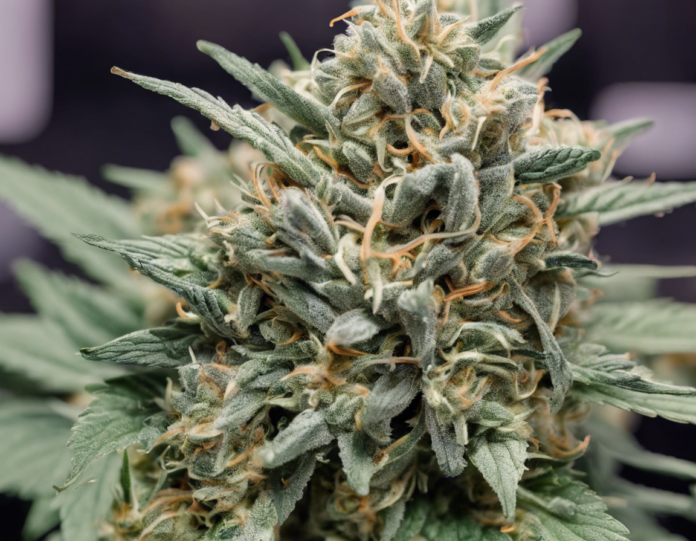Introduction:
Blue Diesel is a popular marijuana strain that has gained a stellar reputation among cannabis enthusiasts for its potent effects and unique flavor profile. In this guide, we will delve into the details of this hybrid strain, exploring its origins, genetics, effects, medical benefits, cultivation tips, and more.
Origins and Genetics:
Blue Diesel is a hybrid strain that results from crossing two famous strains, Blueberry and NYC Diesel. This combination gives Blue Diesel its distinctive aroma, flavor, and effects. The Blueberry lineage contributes to its fruity and sweet taste, while the NYC Diesel genetics add a fuel-like and pungent aroma to the mix.
Appearance and Aroma:
Blue Diesel buds are typically dense and coated in a thick layer of crystal trichomes, giving them a frosty appearance. The nugs often showcase a range of colors, including shades of blue, purple, and green, further accentuating their visual appeal. When properly cured, Blue Diesel emits a strong and skunky aroma with hints of sweet berries and diesel fuel.
Effects and Uses:
Blue Diesel is renowned for its balanced effects, offering users a combination of cerebral euphoria and deep physical relaxation. The strain delivers a potent high that starts with a surge of creative energy and mental clarity, making it ideal for daytime or evening use. As the experience progresses, users may feel a gradual wave of relaxation washing over their body, relieving tension and stress.
Medical Benefits:
Due to its well-rounded effects, Blue Diesel is often sought after for its therapeutic properties. Medical marijuana patients use this strain to alleviate various conditions, including chronic pain, depression, stress, anxiety, and muscle spasms. The strain's uplifting effects can also help improve mood and boost creativity for individuals dealing with mental health issues.
Cultivation Tips:
Blue Diesel can be grown both indoors and outdoors, with some variations in yield and growth patterns. When cultivating indoors, maintain a warm and semi-humid environment to promote healthy growth. Outdoor growers should ensure that their plants receive plenty of sunlight and protection from pests and harsh weather conditions. Blue Diesel plants typically flower in about 8-9 weeks and produce moderate to high yields of potent buds.
Tips for Consumption:
When consuming Blue Diesel, consider starting with a low to moderate dosage, especially if you are sensitive to THC or new to cannabis. The strain's potency can vary depending on the batch and individual tolerance levels. Whether smoking, vaping, or consuming edibles, pace yourself to gauge the effects before increasing your intake.
Potential Side Effects:
Like any cannabis strain, Blue Diesel may cause certain side effects, especially when consumed in large amounts. Common side effects include dry mouth, dry eyes, dizziness, and paranoia. To mitigate these effects, stay hydrated, use eye drops if needed, and consume the strain in a comfortable setting.
Legal Status and Availability:
Blue Diesel is available in states where recreational or medical marijuana is legal. However, restrictions and regulations may vary by region, so it's essential to check local laws before purchasing or growing this strain. Many dispensaries and online platforms offer Blue Diesel products in various forms, including flowers, concentrates, and edibles.
Conclusion:
In conclusion, Blue Diesel is a powerhouse strain that blends the best of its parent genetics to deliver a well-rounded cannabis experience. Whether you seek creative inspiration, relaxation, or therapeutic relief, this hybrid strain has something to offer. With its flavorful profile, balanced effects, and potential medical benefits, Blue Diesel has earned its place among the top choices for cannabis enthusiasts worldwide.
Frequently Asked Questions (FAQs) about Blue Diesel:
1. What is the THC content of Blue Diesel?
Blue Diesel typically boasts a THC content ranging from 15% to 23%, making it a moderately potent strain.
2. Does Blue Diesel have any CBD content?
While Blue Diesel is not known for high CBD levels, some phenotypes may have trace amounts of CBD.
3. How does Blue Diesel compare to other popular strains like Blue Dream or Sour Diesel?
Blue Diesel shares similarities with both Blue Dream and Sour Diesel in terms of effects, but it offers a unique flavor profile that sets it apart.
4. Can I use Blue Diesel during the day?
Yes, Blue Diesel's energizing and creative effects make it suitable for daytime use, but its relaxing properties also make it a good option for unwinding in the evening.
5. Is Blue Diesel recommended for novice cannabis users?
Due to its moderate to high potency, Blue Diesel may be overwhelming for beginners. It is advisable for novice users to start with a lower THC strain.
6. How should I store Blue Diesel buds for optimal freshness?
To preserve the aroma and potency of Blue Diesel buds, store them in a cool, dark place in an airtight container or resealable bag.
7. Can I grow Blue Diesel plants outdoors in a colder climate?
While Blue Diesel prefers a warm and semi-humid environment, it can thrive outdoors in colder climates with proper care and protection from frost.
8. Are there any specific terpenes in Blue Diesel that contribute to its aroma and effects?
Blue Diesel's terpene profile typically includes myrcene, limonene, and caryophyllene, which contribute to its fruity, citrusy, and spicy notes.
9. Does Blue Diesel have any potential interactions with medications or medical conditions?
Individuals with specific medical conditions or who are taking medications should consult with a healthcare professional before using Blue Diesel, as it may interact with certain drugs or exacerbate certain health conditions.
10. Are there any recommended consumption methods for maximizing the effects of Blue Diesel?
While smoking or vaping Blue Diesel flower is popular, consuming concentrates or edibles made from this strain can also intensify its effects, but start with lower doses to gauge tolerance levels.

